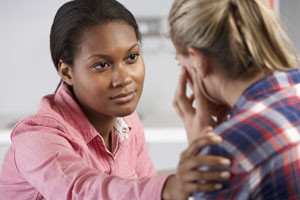Emotional First Aid
By: Rochelle Perper, Ph.D. | September 27, 2014

Most people experience some emotionally traumatic events, ranging from the manageable to the overwhelming, over the course of their lifetimes. Yet, few people know how to help with the emotional aftermath of traumatic events. Both victims and witnesses of trauma may experience feelings of confusion, fear, sadness, and isolation, and often feel at a loss as to how to respond. This article presents practical strategies for bystanders for ways to recognize and manage the hazards of emotionally stressful situations. These strategies seek to alleviate or moderate the immediate emotional stress response in the aftermath of a traumatic event.
Reactions to Traumatic Events
Despite the universality of these experiences, everyone exposed to trauma reacts differently, and many people inevitably feel a tangle of emotions. For these individuals, seemingly senseless events may cause a profound sense of loss of control and produce concerns that the world at large is unsafe.
Some common reactions to a traumatic event include:
- Disbelief and confusion
- Flashbacks or intrusive thoughts about current or previous events
- Distress when exposed to reminders of the incident
- “Survivor guilt” or feelings of self-blame
- Sadness, anger, frustration, restlessness, helplessness and/or emotional numbness
- Feeling a strong need to talk or read about the event
- Fear or anxiety about the future
- Difficulty concentrating or making decisions
- Changes in sleep patterns
- Increased use of nicotine, alcohol or other drugs
It is normal to have some kind of reaction to a traumatic event. The more personal the event, the stronger the response tends to be; however, strong reactions can also occur even when the event is not perceived as personal. Reactions such as blaming those involved are also normal and can be protective, allowing people to maintain their sense of safety.
Some people may begin to recover a sense of normalcy within a short time, even without professional assistance. The support of friends and family can bolster this recovery. Other helpful community resources may include clergy, community leaders, and school or work counseling services. For people who have difficulty coping with the traumatic event, specialized therapy from a Psychologist specializing in trauma is recommended.
What is Emotional First Aid?
Similar to traditional first aid, which involves providing physical support for individuals suffering from illness or injury before professional help is available, emotional first aid focuses on providing emotional support to those affected by traumatic events before crises are resolved or professional help is needed or sought. The main goal of emotional health first aid is to promote safety, calm and hope for those affected by the trauma and to encourage them to trust their own coping skills.
How to Help
- Secure Physical Safety
As in traditional first aid, physical safety is paramount. Once safety is ensured for all, introduce yourself, find out the affected person’s name, and ask if he or she needs any specific assistance or support. Remain calm, and do what you can to create a safe environment; you may even take the person to a calmer or more secure location.
- Maintain Contact
After meeting basic physical needs, the most important step in helping someone is maintaining human contact. Establishing a connection can help to calm people down and orient them to their needs. It may also relax them enough to help you connect them with their existing support network and friends, family and loved ones.
- Provide Emotional Support
People will talk when they are ready and are unlikely to open up if they are pressured to do so. Emotional first aid is not the same as therapy and should not be treated as such. Rather, the goal is to offer support and remind the affect person of the strengths and resources available to them.
- Listen with Empathy
While it is tempting to try to improve the situation for affected individuals, making promises you cannot guarantee or giving information about which you are unsure can have detrimental consequences. When in doubt, the best course often is to say nothing and simply listen. This does not mean remaining quiet and indifferent. You can ask questions and seek clarification as part of active listening. You can also make supportive, but neutral comments such as “that must have been difficult.”
Getting Professional Help
While it is often difficult to determine whether someone will require professional assistance following a traumatic event, watch for these signs:
- Unresponsiveness to his/her environment
- Significant disruptions (lasting more than two weeks) to normal behaviors and habits
- Inability to manage work or school obligations
- Inability to take care of self or family
- Increased or regular use of alcohol or drugs
- Thoughts of suicide
If the person is clearly unable to function or is thinking about suicide, seek immediate help or call 911. In any case, do not hesitate to ask the person how he or she is feeling and be clear about your sincere concern.
Conclusions
Everyone is vulnerable to experience a traumatic event, but the effects do not have to be debilitating. It is important that we recognize how traumas affect us both physically and emotionally. While people recover in their own ways and at their own paces, emotional first aid helps to ensure that affected people’s basic needs are met and that human contact is sustained through a critical stage in responding to trauma. Feeling connected and reassured that one’s reactions to trauma are normal can help with the protection and restoration of a physically and emotionally healthy lifestyle.



